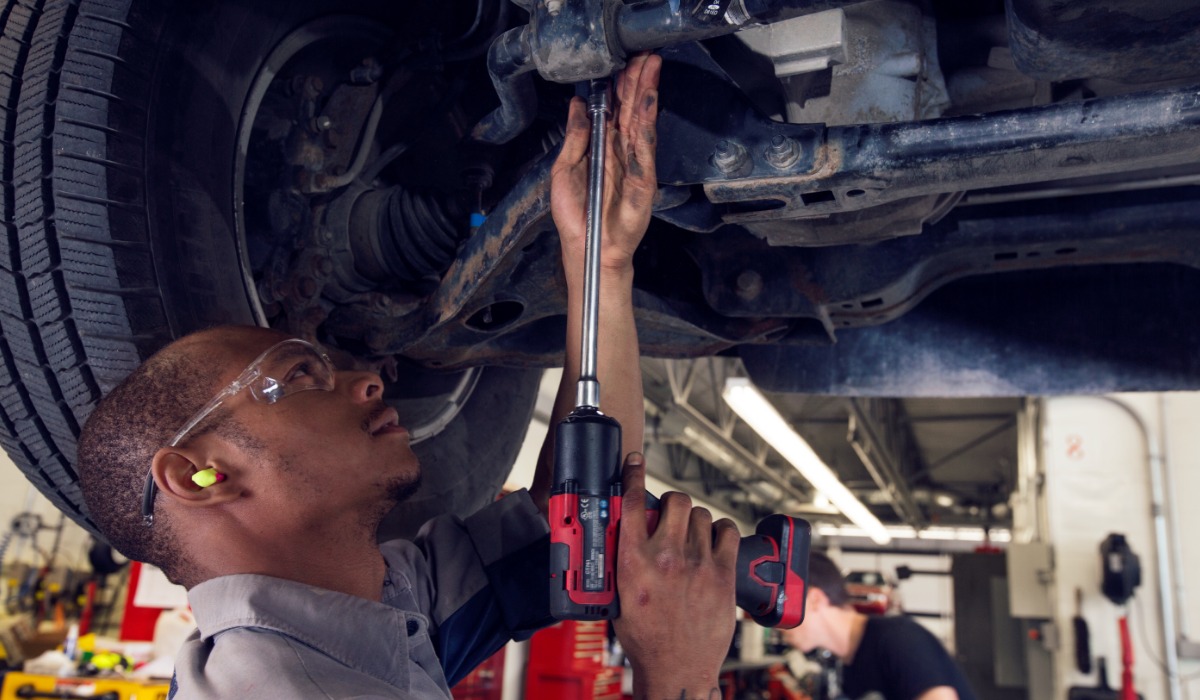Overview
Turn your love of motorcycles and mechanics into a career.
Our 12-week Pre-employment Motorcycle Mechanic program will provide foundational training in the assembly, maintenance, repair and restoration of motorcycles and multi-wheeled lightweight all-terrain vehicles.
A combination of theory and hands-on learning in a shop environment, your classes will explore:
- lubrication and cooling systems
- electrical and ignition systems
- carburetion
- fuel systems
- adjustments of moving parts
- safety protocols.
Designed with input from industry, this program is for those interested in becoming an apprentice but do not yet have any knowledge or training in the field.
You'll graduate with the technical knowledge and skills to become a motorcycle mechanic apprentice and repair, service and maintain motorcycles and other similarly powered vehicles.
Motorcycle mechanics tend to be objective, methodical and innovative.
You need:
- an aptitude for mechanics
- strength and stamina
- good people skills
- a willingness to work long hours during busy seasons
- the ability to safely lift heavy objects
- attention to detail
- hand-eye coordination
- to be reliable
- to take pride in your work.
You should enjoy doing work with precision and problem-solving.
This program aligns with the first period of Alberta Apprenticeship and Industry Training's (AIT) Motorcycle Mechanic curriculum.
Graduates are eligible to register as apprentices and challenge the first-period exam.
Once you pass the exam and complete the necessary training hours with an employer, you may register for SAIT's Motorcycle Mechanic apprenticeship program beginning in period two.
After successfully completing this program, you'll receive a Pre-employment Motorcycle Mechanic certificate.
Careers and opportunities
Our graduates may work in the following occupations. Some careers require additional experience and education.
Associated National Occupational Classification (NOC) codes: 72020, 72410, 72411, 72423, 74203.
Career planning support
Unsure which career path is for you? Here are some recommended career planning resources to help you decide your future.
You can also head to Alberta alis for lots of information about careers in Alberta, including quizzes and labour market information to help you narrow down a path.
Finally, you can take our online career finder quiz, which can help narrow your options based on your current skills and interests.
Courses
The Pre-Employment Motorcycle certificate requires 13.5 credits (seven courses) to complete.
You must take all of the following courses to complete this program.
| Course | Credits |
|---|---|
|
In this course, you will learn the correct handling of crated motorcycles, including inspection of incoming shipments and procedures to report missing or damaged parts. You will learn about receiving shipments, and perform pre-delivery inspections and related tasks, including minor repairs to paint and windshields. Finally, you will learn how to correctly prepare motorcycles for extended periods of storage. |
1.5 |
|
In this course, you will learn to repair and maintain brake systems, including examples found on all-terrain and utility vehicles. You will learn to identify the components and operations of brake systems, describe brake fluid characteristics, and describe hydraulic and mechanical pressures in a multi-piston caliper system. You will also perform inspection, service and repair of drum and disc brake systems, as well as rebuilding master cylinders, wheel cylinders and calipers. |
1.5 |
|
In this course, you will learn basic electrical theory and circuits so that you can perform meter tests to diagnose and repair electrical problems. The electrical principles you learn in class will be reinforced in hands-on activities, such as battery maintenance and testing, safe handling of batteries including Electric Motorcycle batteries. You will also learn to use wiring diagrams to identify electrical problems, and repair electrical wires and connectors. |
3 |
|
In this course, you will learn the operating and design principles of four-stroke and two-stroke engines. You will learn to service motorcycle fuel systems, air filters and air boxes, and perform compression and sealing tests. You will also perform basic engine tune-ups and perform scheduled maintenance procedures. |
3 |
|
In this course, you will learn to use common hand tools, as well as a range of specialized equipment for cleaning, measuring, testing and service work, including wheel, suspension and frame equipment, and engine service and overhaul equipment. You will also learn to safely use an oxyfuel torch to perform heating and cutting and non-structural welding using Gas Metal Arc Welding. |
1.5 |
|
In this course, you will perform complete wheel and tire service and repair. This will involve identifying the types of wheels used for modern motorcycles and describing tire applications, sizes, designs and compatibility. You will also perform visual inspections, wheel bearing replacement, wire spoke tension adjustment, spoke trim replacement, tire removal, mounting and balancing, and removal and replacement of wheel assemblies. You will also learn about all-terrain and utility vehicle wheels and tires. |
1.5 |
|
In this course, you will learn about important safety legislation, regulations and industry policies in the workplace, including climbing, lifting, rigging, hoisting, hazardous materials and fire protection. As well, you will learn and use shop information systems to interpret work orders and create parts requisitions. Finally, you will identify and use common motorcycle shop equipment, perform thread repair procedures, and perform thread cleaning, repairing, cutting and broken fastener removal procedures. |
1.5 |
Progression
You must attain a PGPA and/or a CGPA of 2.0 or better each semester and pass the prerequisite courses to progress through the program.
To qualify for graduation, you must pass all courses, attain a CGPA of 2.0 or better and complete course requirements within the prescribed timelines.
Admission requirements
Domestic requirements
Applicants must demonstrate English language proficiency and completion of the following courses or equivalents:
- at least 50% English Arts 20-1 or English Arts 20-2, and
- at least 50% Math 20-1 or Math 20-2 or 60% in Math 20-3, and
- at least 50% in one Grade 11 Science.
SAIT accepts high school course equivalents for admission for applicants educated outside Alberta.
All applicants who were educated outside of Canada must demonstrate English language proficiency and provide proof they meet the program admission requirements outlined above with an international document assessment. Find accepted educational documents and assessment options.
SAIT may also accept courses completed at certain international post-secondary institutions.
Academic Upgrading
Missing an admission requirement for this program? Upgrade your prior education to help you receive admission into one of SAIT's career programs.
English language proficiency
All applicants must demonstrate English language proficiency prior to admission, including students educated in Canada.
Transfer agreements
At SAIT, we have created transfer agreements with partner institutions to allow you to earn course credits toward your SAIT program based on your previously completed credentials.
Transfer Alberta search tool
Use the Transfer Alberta search tool to see all transfer agreements between Alberta post-secondary institutions (including those with the University of Calgary, Mount Royal University and Bow Valley College.)
Search transfer agreements in Alberta
Transfer options for graduates
When you have completed this program, you may continue your education at a partner post-secondary institution. These transfer agreements include partnerships within and/or outside of Canada.
Available intakes
There are no intakes scheduled at this time. Please check back for updates.
Costs
2025/26 tuition and fees
The following estimated costs are effective as of July 1, 2025.
The estimated total cost of tuition and fees is based on completing the program within 12 weeks. Following a modified schedule will impact the fees you pay per semester and may alter final costs.
Domestic students
**Students in this program do not qualify for the UPass or health and dental plans, nor do they pay Saitsa fees.
Books and supplies are approximately $625.
This is a bring-your-own-device program with a standard computer hardware and software requirement. See the specific requirements on our computers and laptops page.
Find your booklist on the SAIT Bookstore's website. The booklist will be available approximately two weeks before classes begin. Your learning resources will cost approximately $115.
Required personal protective equipment (PPE)
You'll require:
- steel-toed boots
- coveralls
- safety glasses
These will cost between $250 and $500 total. You'll be able to use this PPE once you graduate and begin work.
Financial aid
Paying for your education may feel overwhelming, but we have resources and programs that can help, including information about payment options, student loans, grants and scholarships.
Application process
Ready to apply?
Follow our step-by-step guide to submitting a successful application.
Communication during admission
Email is the primary source of communication during the selection process. Ensure your personal email account is managed appropriately to receive our emails, files and communications. We recommend you add the transportation.info@sait.ca domain to your safe senders list or you risk missing critical email messages.
Begin your application
Apply now using the online application portal.
Ensure you have a valid Visa or Mastercard to pay the non-refundable application fee of $120 for domestic applicants.
Information sessions
Prepare for a strong start in your chosen program or get the details you need to decide your future path.
Our expert staff and faculty are ready to answer your questions and provide information about the following:
What sets SAIT apart
- An introduction to the program and area of study
- Admission requirements
- Future career paths
- Information on the earning potential and graduate employment rates.
Contact us
School of Transportation Advising
-
Phone - 403.284.8471
Subscribe for updates
Your journey starts here! Sign up to get important updates on:
- Transportation and logistics programs
- Application information
- Relevant news and events

Oki, Âba wathtech, Danit'ada, Tawnshi, Hello.
SAIT is located on the traditional territories of the Niitsitapi (Blackfoot) and the people of Treaty 7 which includes the Siksika, the Piikani, the Kainai, the Tsuut’ina and the Îyârhe Nakoda of Bearspaw, Chiniki and Goodstoney.
We are situated in an area the Blackfoot tribes traditionally called Moh’kinsstis, where the Bow River meets the Elbow River. We now call it the city of Calgary, which is also home to the Métis Nation of Alberta.




